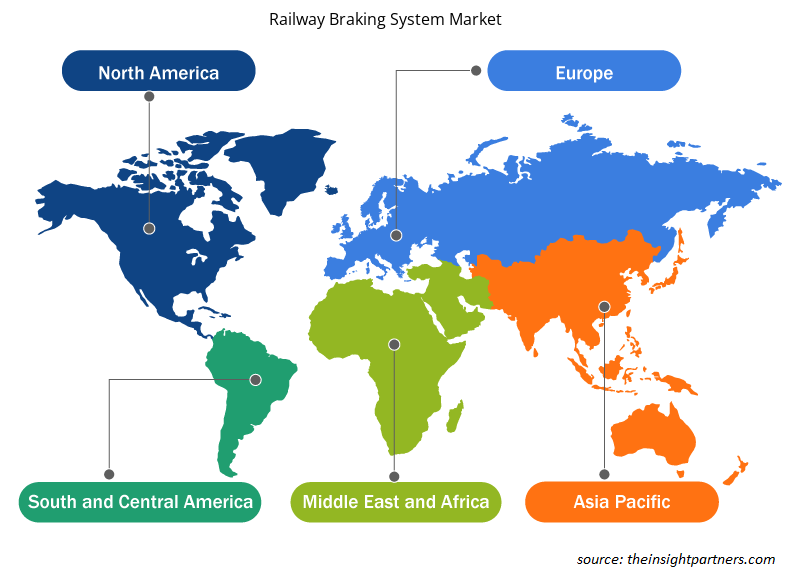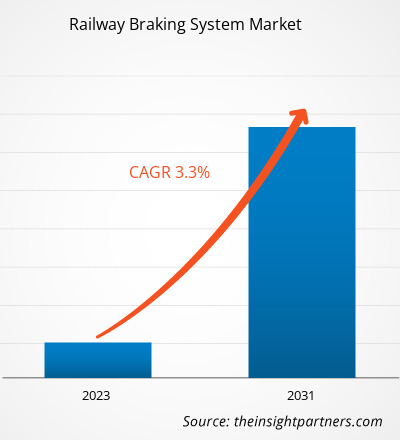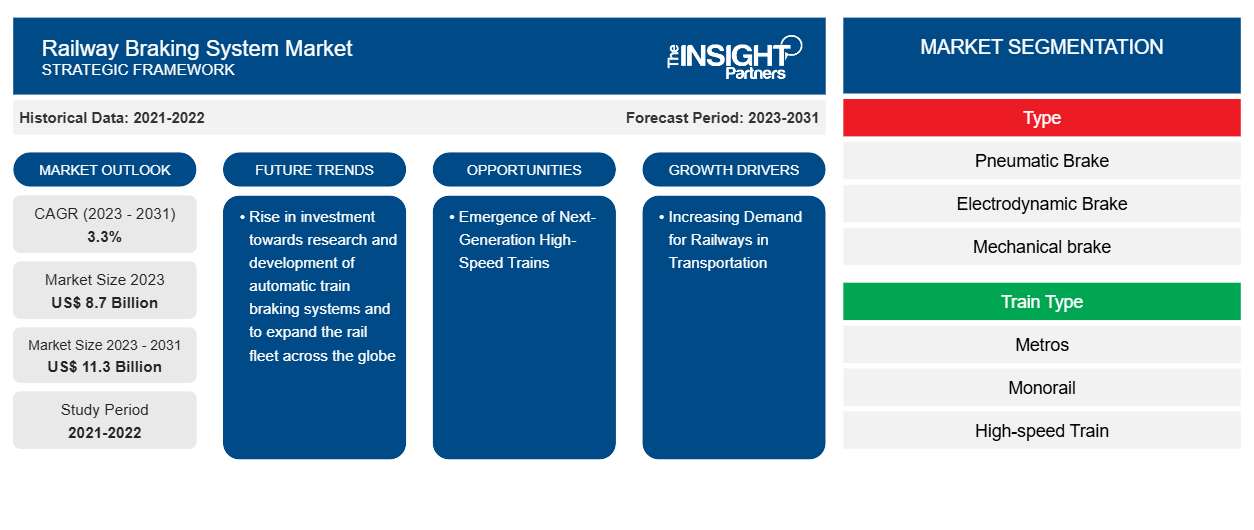철도 제동 시스템 시장 규모는 2023년 87억 달러에서 2031년까지 113억 달러에 이를 것으로 예상됩니다. 이 시장은 2023~2031년에 3.3%의 CAGR을 기록할 것으로 예상됩니다. 자동 열차 제동 시스템 연구 및 개발에 대한 투자 증가와 전 세계적으로 철도 차량 확장은 철도 제동 시스템 시장을 주도하는 주요 추세 중 하나입니다.
철도 제동 시스템 시장 분석
개인 간 철도 교통에 대한 수요 증가와 지하철, 모노레일, 고속철도의 새로운 철도와 노선을 건설하기 위한 철도 프로젝트 증가와 같은 요인. 철도 부문을 확장하기 위한 정부 투자 증가와 결합된 프로젝트는 철도 부문을 강화하는 방향으로 계속 진행되고 있습니다. 철도 부문이 성장함에 따라 브레이크를 포함한 안전 시스템을 통합하는 범위가 큰 추진력을 얻고 있습니다. 또한 신흥 경제권에서 자동 열차 제동 시스템, 자동 열차 운영 및 차세대 고속 열차가 도입되면서 제동 시스템 시장이 성장하는 또 다른 요인이 되었습니다. 또한 국가에서 볼륨 패키지와 무역이 증가함에 따라 항공에 비해 가장 저렴한 운송 수단이기 때문에 철도 사용에 영향을 미치고 있습니다. 따라서 화물 사업이 호황을 누리면서 화물 철도의 개발 주기도 증가했습니다. 경전철의 개발이 증가함에 따라 제동 시스템의 통합도 증가할 것입니다.
철도 제동 시스템 시장 개요
지속 가능성, 도시화, 이동성 차량 및 디지털화와 같은 주요 메가트렌드에 비추어 볼 때 운송 산업은 엄청난 성장을 목격하고 있습니다. 위에서 언급한 트렌드는 미래 이동성을 위한 장기적으로 지속 가능한 성장 기회를 제공함으로써 철도 부문에 도움이 될 것입니다. 또한 철도 부문에 관련된 엄격한 안전 및 품질 표준으로 인해 고급 시스템 및 장비의 통합이 증가하고 있습니다. 철도 부문에서 이중 탄성 고정 장치가 있는 트랙, 자동 주행 , 가공 전력 케이블/제3 레일 및 통신 기반 열차 제어 신호 시스템은 지하철 노선에 통합되고 있는 몇 가지 기술 중 일부입니다. 이러한 고급 기술을 지하철 레일에 통합하면 레일 제동 시스템을 통합할 수 있는 범위를 늘리는 데 필수적인 역할을 할 것입니다.
귀하의 요구 사항에 맞게 이 보고서를 사용자 정의하세요
이 보고서의 일부 또는 국가 수준 분석, Excel 데이터 팩을 포함하여 모든 보고서에 대한 사용자 정의를 무료로 받을 수 있으며 신생 기업 및 대학을 위한 훌륭한 혜택과 할인 혜택을 이용할 수 있습니다.
-
이 보고서의 주요 시장 동향을 알아보세요.이 무료 샘플에는 시장 동향부터 추정 및 예측까지 다양한 데이터 분석이 포함됩니다.
철도 제동 시스템 시장 동인 및 기회
교통 분야에서 철도에 대한 수요 증가
철도 운송은 도로 운송과 비교했을 때 주로 안전하고 경제적인 운송 수단으로 간주됩니다. 높은 정밀도와 최대 지리적 영역을 커버할 수 있는 능력과 같은 요소와 관련하여 여행객 사이에서 수요가 증가하고 있습니다. 기차, 화물 및 승객의 안전을 보장하기 위해 제동 시스템은 철도에 사용되는 시스템 중 하나입니다. 또한 새로운 철도 인프라를 구축하고 기차 연결성을 확장하기 위한 투자를 늘리는 Dubai Route 2020 Metro와 같은 정부 프로젝트는 철도 부문의 성장에 기여하고 있습니다. 화물 운송을 위한 철도에 대한 수요도 증가하고 있습니다. 철도를 통해 운송되는 패키지와 상품의 양이 증가함에 따라 기차의 수도 증가하고 있습니다. 철도를 통한 대량의 화물 운송은 기차와 기타 기차 관련 시스템 제조업체 모두에게 수익성 있는 기회를 창출하고 있습니다. 따라서 화물 운송과 철도 승객을 늘리는 이러한 측면은 철도 부문의 성장을 촉진하고 국가 정부가 철도 프로젝트에 막대한 투자를 하도록 동기를 부여하고 있습니다.
차세대 고속철도의 등장
끊임없는 기술 발전의 시대에 전 세계 철도 산업은 전체 부문을 혁신하는 데 중요한 역할을 하는 새로운 기술과 시스템을 경험하고 있습니다. 예를 들어, 2024년 4월, 한국은 차세대 고속 탄환열차를 공개했습니다. 이 열차의 최대 속도는 320km/h입니다. 또한, 2023년 10월, 프랑스는 차세대 고속 TGV M 열차를 공개했으며, 2025년에 운행을 시작할 예정입니다. 이러한 기술 발전과 전 세계적으로 고속열차가 등장하면서 예측 기간 동안 철도 제동 시스템 시장 수요가 증가할 것으로 예상됩니다.
또한 차세대 에어 디스크 브레이크의 등장은 레일을 변형하는 길을 만들고 있습니다. 또한 직접 브레이크 시스템에서 브레이크 명령은 더 짧은 시간 지연으로 빠르게 전송됩니다. 나아가, 합작 사업인 Shift2Rail은 운전자가 태블릿을 통해 캐빈에서 브레이크를 테스트할 수 있는 디지털 브레이크 테스트 솔루션을 개발하고 있습니다. 이 디지털 브레이크 테스트 솔루션은 유연성과 안전성을 향상시키는 동시에 시간과 노동 비용을 절감하는 데 도움이 될 것입니다. 차세대 모빌리티 시대에 고속 열차, 디지털 테스트 브레이크 솔루션, 차세대 브레이크의 등장은 철도 부문이 미래에 대비할 수 있도록 도울 것입니다. 언급된 모든 측면은 철도 브레이크 시스템 채택에서 중요한 위치를 차지할 것으로 예상됩니다.
철도 제동 시스템 시장 보고서 세분화 분석
철도 제동 시스템 시장 분석에 기여한 주요 세그먼트는 유형과 열차 유형입니다.
- 철도 제동 시스템 시장은 유형에 따라 공압 브레이크, 전기 역학 브레이크, 기계식 브레이크, 전자기 브레이크로 구분되었습니다. 공압 브레이크 인치 세그먼트는 2023년에 더 큰 시장 점유율을 차지했습니다.
- 열차 유형에 따라 철도 제동 시스템 시장은 지하철, 모노레일, 고속철도, 경전철/트램, 화물열차로 구분되었습니다. 경전철/트램 노선 세그먼트는 2023년에 더 큰 시장 점유율을 차지했습니다.
지역별 철도 제동 시스템 시장 점유율 분석
철도 제동 시스템 시장 보고서의 지리적 범위는 주로 북미, 유럽, 아시아 태평양, 중동 및 아프리카, 남미의 5개 지역으로 나뉩니다.
아시아 태평양 지역은 2023년에 철도 제동 시스템 시장을 장악할 것입니다. 아시아 태평양 지역에는 호주, 중국, 일본, 인도, 한국 및 기타 아시아 태평양 지역이 포함됩니다. 안정적인 경제와 기술 발전은 이 지역의 다양한 산업과 시장의 성장을 지원합니다. 동남아시아 지역의 지역 철도 네트워크 연결성은 Pan Asia 철도 네트워크에서 기존 노선을 연결하는 여러 프로젝트가 시행됨에 따라 개선되고 있습니다. 중국 정부가 지원하고 계획한 새로운 철도 프로젝트는 동남아시아 본토의 주요 도시 간 연결을 보장할 것입니다. 중국의 쿤밍에서 방콕, 싱가포르, 쿠알라룸푸르까지 이어지고 라오스의 비엔티안에서 방콕까지 이어지는 중앙 노선, 베트남의 하노이시와 호치민시, 캄보디아의 프놈펜을 통과하는 동부 노선, 미얀마의 양곤을 통과하는 서부 노선이 있습니다.
인도네시아와 필리핀도 주요 도시와 주요 섬을 연결하는 철도 프로젝트를 계획했습니다. 필리핀, 태국, 중국, 인도의 철도 부문은 첨단 기술을 통합하여 철도 교통을 강화하기 위해 각자의 영토에 막대한 투자를 하고 있습니다. 또한 일본은 도로의 혼잡을 줄이고 승객이 시간과 비용을 절약할 수 있도록 고속철도를 사용하는 주요 국가 중 하나입니다.
철도 제동 시스템 시장 지역 통찰력
Insight Partners의 분석가들은 예측 기간 동안 철도 제동 시스템 시장에 영향을 미치는 지역적 추세와 요인을 철저히 설명했습니다. 이 섹션에서는 북미, 유럽, 아시아 태평양, 중동 및 아프리카, 남미 및 중미의 철도 제동 시스템 시장 세그먼트와 지리에 대해서도 설명합니다.

- 철도 제동 시스템 시장에 대한 지역별 특정 데이터 얻기
철도 제동 시스템 시장 보고서 범위
| 보고서 속성 | 세부 |
|---|---|
| 2023년 시장 규모 | 87억 달러 |
| 2031년까지 시장 규모 | 113억 달러 |
| 글로벌 CAGR (2023-2031) | 3.3% |
| 역사적 데이터 | 2021-2022 |
| 예측 기간 | 2023-2031 |
| 다루는 세그먼트 |
유형별로
|
| 포함된 지역 및 국가 |
북아메리카
|
| 시장 선도 기업 및 주요 회사 프로필 |
|
시장 참여자 밀도: 비즈니스 역학에 미치는 영향 이해
철도 제동 시스템 시장은 소비자 선호도의 변화, 기술 발전, 제품의 이점에 대한 인식 증가와 같은 요인으로 인해 최종 사용자 수요가 증가함에 따라 빠르게 성장하고 있습니다. 수요가 증가함에 따라 기업은 제품을 확장하고, 소비자의 요구를 충족하기 위해 혁신하고, 새로운 트렌드를 활용하여 시장 성장을 더욱 촉진하고 있습니다.
시장 참여자 밀도는 특정 시장이나 산업 내에서 운영되는 회사나 기업의 분포를 말합니다. 주어진 시장 공간에 얼마나 많은 경쟁자(시장 참여자)가 존재하는지 그 규모나 전체 시장 가치에 비해 나타냅니다.
철도 제동 시스템 시장에서 운영되는 주요 회사는 다음과 같습니다.
- 다코-CZ
- 아케보노 브레이크 공업 주식회사
- 암스테드 레일
- 크노르브렘세 AG
- 나브테스코 주식회사
- 세이버 레일 서비스 유한회사
면책 조항 : 위에 나열된 회사는 어떤 특별한 순서에 따라 순위가 매겨지지 않았습니다.

- 철도 제동 시스템 시장 주요 업체 개요를 알아보세요
철도 제동 시스템 시장 뉴스 및 최근 개발
철도 제동 시스템 시장은 1차 및 2차 조사 이후의 정성적, 정량적 데이터를 수집하여 평가합니다. 여기에는 중요한 기업 간행물, 협회 데이터 및 데이터베이스가 포함됩니다. 다음은 철도 제동 시스템 시장과 전략에 대한 시장의 개발 목록입니다.
- 2024년 1월, Wabtec Corporation은 Siemens India Private Limited에 1억 5,700만 달러 규모의 브레이크 시스템을 주문했습니다. 이 공급 계약을 통해 Siemens Limited는 1,200대의 새로운 전기 기관차에 대해 향상된 작동 성능, 효율성 및 안전성을 갖춘 브레이크 시스템을 제공할 것입니다.
- 2023년 10월, Siemens Mobility는 새로운 공기 없는 브레이크 시스템을 출시했습니다. 이 새로운 브레이크 시스템은 철도 차량의 마찰 브레이크를 완전히 전기적으로 제어할 수 있게 해주고 회사의 제품 포트폴리오를 강화합니다.
철도 제동 시스템 시장 보고서 범위 및 제공물
"철도 제동 시스템 시장 규모 및 예측(2021-2031)" 보고서는 아래 영역을 포괄하는 시장에 대한 자세한 분석을 제공합니다.
- 범위에 포함된 모든 주요 시장 세그먼트에 대한 글로벌, 지역 및 국가 수준의 시장 규모 및 예측
- 동인, 제약 및 주요 기회와 같은 시장 역학
- 주요 미래 트렌드
- 포터의 5가지 힘에 대한 자세한 분석
- 주요 시장 동향, 주요 업체, 규정 및 최근 시장 동향을 포괄하는 글로벌 및 지역 시장 분석
- 시장 집중도, 히트맵 분석, 유명 기업 및 최근 개발 사항을 포함하는 산업 환경 및 경쟁 분석
- SWOT 분석을 통한 자세한 회사 프로필
- 과거 분석(2년), 기준 연도, CAGR을 포함한 예측(7년)
- PEST 및 SWOT 분석
- 시장 규모 가치/거래량 - 글로벌, 지역, 국가
- 산업 및 경쟁 환경
- Excel 데이터세트
최근 보고서
사용 후기
구매 이유
- 정보에 기반한 의사 결정
- 시장 역학 이해
- 경쟁 분석
- 고객 인사이트
- 시장 예측
- 위험 완화
- 전략 기획
- 투자 타당성 분석
- 신흥 시장 파악
- 마케팅 전략 강화
- 운영 효율성 향상
- 규제 동향에 발맞춰 대응























 무료 샘플 받기 - 철도 제동 시스템 시장
무료 샘플 받기 - 철도 제동 시스템 시장